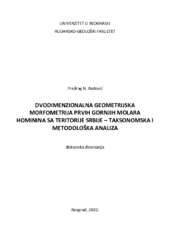Приказ основних података о документу
Dvodimenzionalna geometrijska morfometrija prvih gornjih molara hominina sa teritorije Srbije - taksonomska i metodološka analiza
Two-dimensional geometric morphometrics of hominin upper first molars from the territory of Serbia - a taxonomic and methodological analysis
| dc.contributor.advisor | Bogićević, Katarina | |
| dc.contributor.other | Roksandić, Mirjana | |
| dc.contributor.other | Đerić, Nevenka | |
| dc.contributor.other | Nenadić, Draženko | |
| dc.contributor.other | Radulović, Barbara | |
| dc.creator | Radović, Predrag | |
| dc.date.accessioned | 2022-12-26T12:31:35Z | |
| dc.date.accessioned | 2023-11-20T14:59:47Z | |
| dc.date.available | 2022-12-26T12:31:35Z | |
| dc.date.available | 2023-11-20T14:59:47Z | |
| dc.date.issued | 2022 | |
| dc.identifier.uri | https://eteze.bg.ac.rs/application/showtheses?thesesId=8917 | |
| dc.identifier.uri | https://fedorabg.bg.ac.rs/fedora/get/o:27292/bdef:Content/download | |
| dc.identifier.uri | https://plus.cobiss.net/cobiss/sr/sr/bib/76861449 | |
| dc.identifier.uri | https://nardus.mpn.gov.rs/handle/123456789/21108 | |
| dc.identifier.uri | http://reff.f.bg.ac.rs/handle/123456789/5354 | |
| dc.description.abstract | Primarni cilj ove studije tiče se taksonomske identifikacije fosilnih prvih gornjih molara (M1)hominina pronađenih u Srbiji, primenom metoda dvodimenzionalne (2D) geometrijskemorfometrije. U prvoj (metodološkoj) fazi istraživanja ispitana je efikasnost 16 različitihpristupa (geometrijskih modela) u klasifikaciji M1 neandertalaca i anatomski modernogčoveka. Modeli su testirani na dva seta okluzalnih projekcija krunica (n = 34 i n = 64) dobijenihorijentisanjem digitalnih 3D modela u virtuelnom okruženju ili fotografisanjem fizičkihprimeraka zuba. Prilikom testiranja primenjena je klasifikacija zasnovana na linearnojdiskriminantnoj analizi (LDA) sa unakrsnom validacijom (jackknifing), gde su kao varijablekorišćeni setovi glavnih komponenti (PC) koji kumulativno opisuju ≥ 90% totalne varijanse.Modeli su ispitani uporedo u prostorima oblika i forme. Najefikasniji modeli (sa najvišimstopama tačnih klasifikacija) primenjeni su u narednoj fazi studije. Identifikacije fosilnihmolara iz pleistocenskih slojeva pećina Pešturine (Pes-3) i Velike Balanice (BH-4 i BH-6)izvršena je primenom modela sa oznakama Komb3A i FragA, na proširenim uzorcima.Rezultati LDA klasifikacija bez izuzetka pokazuju da su svi ispitani molari pripadalineandertalcima, što potvrđuje prisustvo ove grupe drevnih hominina na teritoriji današnjeSrbije tokom srednjeg i kasnog dela pleistocenske epohe. Zajedno sa drugim nalazima iz sloja3a Velike Balanice (čija je starost procenjena na čak 369–211 hiljada godina), zub BH-4predstavlja verovatno najraniji fosilni zapis neandertalaca na Balkanu. Upadljiva morfološkasličnost primerka BH-4 i Sima de los Huesos uzorka (starosti oko 430 hiljada godina)predstavlja indikaciju vrlo rane ekspanzije neandertalaca sa zapada ka istoku Evrope. | sr |
| dc.description.abstract | The primary goal of this study concerns the taxonomic identification of hominin fossil upperfirst molars (M1) found in Serbia, using the methods of two-dimensional (2D) geometricmorphometrics. In the first (methodological) phase of the research, the efficiency of 16different approaches (geometric models) to the classification of Neanderthal and anatomicallymodern human M1s was examined. The models were tested on two sets of occlusal projectionsof crowns (n = 34 and n = 64) obtained by orienting digital 3D models in a virtual environmentor by photographing physical specimens of teeth. During the testing, a classification based onlinear discriminant analysis (LDA) with cross-validation (jackknifing) was applied, where setsof principal components (PCs) were used as variables, cumulatively describing ≥ 90% of thetotal variance. The models were tested both in shape space and form space. The most efficientmodels (with the highest correct classification rates) were applied in the next phase of the study.Identifications of fossil molars from the Pleistocene strata of Pešturina (Pes-3) and VelikaBalanica caves (BH-4 and BH-6) were performed using models designated Komb3A andFragA, using expanded samples. The results of LDA classifications, without exception, showthat all examined molars belonged to Neanderthals, which confirms the presence of this ancienthominin group on the territory of today's Serbia during the middle and late parts of thePleistocene epoch. Together with other finds from Layer 3a of Velika Balanica (the age ofwhich is estimated at 369–211 ka), the BH-4 tooth is probably the earliest fossil record ofNeanderthals in the Balkans. The striking morphological similarity between the BH-4specimen and the Sima de los Huesos sample (about 430 ka old) represents an indication of avery early Neanderthal expansion from Western to Eastern Europe. | en |
| dc.format | application/pdf | |
| dc.language | sr | |
| dc.publisher | Универзитет у Београду, Рударско-геолошки факултет | sr |
| dc.rights | openAccess | en |
| dc.rights.uri | https://creativecommons.org/licenses/by-nc-nd/4.0/ | |
| dc.source | Универзитет у Београду | sr |
| dc.subject | 2D geometrijska morfometrija | sr |
| dc.subject | 2D geometric morphometrics | en |
| dc.subject | prvi gornji molar (M1) | sr |
| dc.subject | taksonomska identifikacija | sr |
| dc.subject | neandertalci | sr |
| dc.subject | anatomski moderni ljudi | sr |
| dc.subject | Pešturina | sr |
| dc.subject | Velika Balanica | sr |
| dc.subject | upper first molar (M1) | en |
| dc.subject | taxonomic identification | en |
| dc.subject | Neanderthals | en |
| dc.subject | anatomically modern humans | en |
| dc.subject | Pešturina | en |
| dc.subject | Velika Balanica | en |
| dc.subject | Serbia | en |
| dc.title | Dvodimenzionalna geometrijska morfometrija prvih gornjih molara hominina sa teritorije Srbije - taksonomska i metodološka analiza | sr |
| dc.title.alternative | Two-dimensional geometric morphometrics of hominin upper first molars from the territory of Serbia - a taxonomic and methodological analysis | en |
| dc.type | doctoralThesis | en |
| dc.rights.license | BY-NC-ND | |
| dc.identifier.fulltext | http://reff.f.bg.ac.rs/bitstream/id/13411/Disertacija_13039.pdf | |
| dc.identifier.fulltext | http://reff.f.bg.ac.rs/bitstream/id/13412/Referat.pdf | |
| dc.identifier.rcub | https://hdl.handle.net/21.15107/rcub_nardus_21108 |


